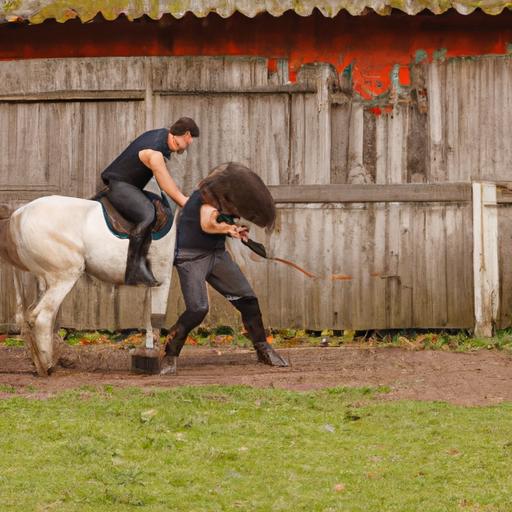Unlock the ancient secrets of horse training with the Kikkuli Method. Enhance your bond, develop your horse’s potential, and solve behavioral issues.
Are you looking to deepen your connection with your equine companion while improving their physical and mental prowess? Look no further than the time-tested kikkuli method of horse training. This ancient training technique holds immense historical significance and continues to revolutionize the way we interact with horses today.
A Brief Overview of the Kikkuli Method
The Kikkuli method, originating from ancient Mesopotamia, has withstood the test of time, proving its efficacy in developing well-rounded and obedient horses. This method emphasizes the importance of communication, trust-building, and establishing a solid foundation of groundwork. By adhering to the principles of the Kikkuli method, you can forge a deep bond with your horse and unlock their true potential.
The Historical Significance
Dating back thousands of years, the Kikkuli method was first documented in ancient texts, showcasing its prominence in early civilizations. This training technique was utilized by renowned horsemen and civilizations, including the Hittites and Assyrians, who recognized its ability to enhance the agility, endurance, and overall performance of their horses. Today, the Kikkuli method continues to inspire modern trainers, reinforcing its enduring legacy in the equestrian world.
What to Expect in this Article
Throughout this comprehensive guide, we will delve into the history, principles, and practical implementation of the Kikkuli method. You will gain a thorough understanding of the core ideologies behind this training approach and learn step-by-step techniques to apply it effectively. We will explore the myriad benefits and advantages of the Kikkuli method, empowering you to nurture a deeper connection with your equine partner.
So, saddle up and prepare to embark on a journey that transcends time and bridges the gap between ancient wisdom and modern horsemanship. Let’s unlock the secrets of the Kikkuli method together, revolutionizing your training approach and nurturing a bond that will elevate your horsemanship to new heights. Stay with us as we unlock the hidden potential of the Kikkuli method, right here at Horsemasterypro.com.
Origins and History of the Kikkuli Method

The Ancient Origins of the Kikkuli Method
The roots of the Kikkuli method can be traced back to ancient Mesopotamia, a region known for its rich equestrian heritage. It was during this time that the Hittites, an ancient civilization, documented their training techniques in the Kikkuli texts. These texts, written in the Hittite language, provide us with valuable insights into the training methods employed by this ancient civilization.
Historical Context and Its Relevance in Horse Training
The Kikkuli method emerged in a time when horses played a vital role in warfare, transportation, and agriculture. The success and survival of civilizations often depended on the strength and capabilities of their equine companions. The Kikkuli method, with its focus on developing well-rounded and disciplined horses, became an integral part of ensuring the effectiveness of horse-based activities.
As horsemanship evolved over time, the Kikkuli method continued to influence subsequent training techniques. Its principles were embraced by numerous cultures and civilizations, including the Assyrians, who further refined and expanded upon the method. The enduring relevance of the Kikkuli method can be attributed to its effectiveness in fostering a harmonious partnership between human and horse.
Notable Figures or Civilizations Associated with the Method
The Hittites and Assyrians stand as notable figures in the history of the Kikkuli method. The Hittites, renowned for their equestrian prowess, meticulously recorded their training techniques, allowing us to gain valuable insights into the ancient origins of this method. The Assyrians, known for their military might, further developed and implemented the Kikkuli method to enhance their cavalry units and ensure success on the battlefield.
By understanding the historical context and the civilizations associated with the Kikkuli method, we gain a deeper appreciation for its time-tested effectiveness. The legacy of these ancient horsemen continues to inspire and guide modern equestrians in their pursuit of excellence. Join us as we explore the principles and techniques that define the Kikkuli method, unlocking the secrets of this ancient art form.
Understanding the Principles of the Kikkuli Method
Core Principles and Ideologies
At the heart of the Kikkuli method lies a set of core principles and ideologies that form the foundation of this remarkable training approach. By understanding these principles, you can unlock the true potential of your horse and foster a harmonious partnership.
The Kikkuli method emphasizes the importance of mutual respect, patience, and consistency. It encourages trainers to approach their equine partners with empathy and understanding, recognizing that each horse is an individual with unique needs and capabilities. By tailoring your training methods to suit the temperament and learning style of your horse, you can establish a solid groundwork for success.
Communication and Trust-Building
Communication is the cornerstone of the Kikkuli method. By establishing clear, effective communication channels with your horse, you can develop a language of cues, signals, and body language that fosters understanding and cooperation. This method encourages trainers to listen to their horses, interpreting their subtle cues and responding in a manner that builds trust and confidence.
Trust-building is another crucial aspect of the Kikkuli method. By creating a safe and positive training environment, you can cultivate a deep bond with your horse based on trust and respect. Through patience, consistency, and rewarding positive behaviors, you can instill confidence in your horse and establish a solid foundation for further training.
Comparisons to Other Horse Training Methods
While there are numerous horse training methods available, the Kikkuli method stands out for its emphasis on communication, trust-building, and individualized approaches. Unlike more forceful or dominant training techniques, the Kikkuli method prioritizes the welfare and well-being of the horse, fostering a cooperative and willing partnership.
In comparison to traditional training methods that rely on dominance, submission, or punishment, the Kikkuli method offers a more holistic and empathetic approach. By focusing on building a strong bond and understanding with your horse, you can achieve remarkable results while fostering a positive and enriching training experience.
As we delve deeper into the practical implementation of the Kikkuli method, we will explore how these principles come into play and how they differentiate this approach from other popular horse training methods. Join us in the next section as we uncover the step-by-step guide to implementing the Kikkuli method, right here at Horsemasterypro.com.
Step-by-Step Guide to Implementing the Kikkuli Method
A. Overview of the Basic Training Steps Involved
To successfully implement the Kikkuli method, it is crucial to understand the fundamental training steps that form the foundation of this approach. These steps serve as a roadmap to guide you towards cultivating a harmonious partnership with your horse. From establishing trust to refining communication, each step is designed to develop a well-rounded and obedient equine companion.
B. Importance of Groundwork and Establishing a Solid Foundation
Groundwork plays a pivotal role in the Kikkuli method, setting the stage for a successful training journey. By engaging in groundwork exercises, you establish a strong bond with your horse, build trust, and develop mutual respect. This essential step allows you to lay a solid foundation for further training, ensuring a safe and cooperative equine partner.
C. Techniques and Exercises Specific to the Kikkuli Method
Within the realm of the Kikkuli method, various techniques and exercises are employed to hone your horse’s skills and maximize their potential. From longeing and long-reining to liberty work and obstacle training, these specific exercises cater to the unique principles of the Kikkuli method. By incorporating these techniques into your training regimen, you will witness remarkable progress and witness your horse’s capabilities flourish.
As you delve into the practical implementation of the Kikkuli method, keep in mind that patience, consistency, and understanding are key. Each horse is unique, and it is important to adapt the training approach to suit their individual needs. By following the step-by-step guide and embracing the techniques and exercises specific to the Kikkuli method, you will witness firsthand the transformation of your equine partner into a confident, well-rounded, and responsive companion. Stay with us as we navigate through the intricacies of implementing the Kikkuli method in the next section.
Conclusion
In conclusion, the Kikkuli method of horse training offers a remarkable opportunity to foster a stronger bond and partnership between you and your horse. By adhering to its fundamental principles and implementing the step-by-step techniques outlined in this guide, you can unlock a world of benefits and advantages.
The Power of Connection and Bonding
One of the key advantages of the Kikkuli method is its ability to enhance the horse-human relationship. Through effective communication, trust-building, and mutual understanding, this training approach allows you to develop a deep connection with your equine companion. The bond that forms as a result not only enriches your horsemanship but also creates a harmonious partnership based on mutual respect and trust.
Unleashing Physical and Mental Development
The Kikkuli method focuses not only on training specific behaviors but also on improving the overall physical and mental well-being of your horse. By incorporating groundwork and exercises tailored to this method, you can enhance their agility, coordination, and strength. Moreover, this approach stimulates their mental faculties, keeping them engaged and fulfilled in their training sessions.
Solving Behavioral Issues
Is your horse exhibiting challenging behaviors? The Kikkuli method provides a potential solution. By addressing the underlying causes of behavioral issues through effective communication and trust-building, this training approach can help you overcome challenges such as anxiety, fear, and stubbornness. The comprehensive nature of the Kikkuli method allows for a holistic approach to resolving behavioral issues, ensuring a harmonious and fulfilling partnership with your horse.
In conclusion, the Kikkuli method of horse training offers a profound opportunity to tap into the ancient wisdom that has stood the test of time. By implementing this method, you can unlock the true potential of your horse and nurture a bond that transcends the realms of horsemanship. Embrace the Kikkuli method and witness the profound transformation it brings to your journey as an equestrian.
Boldly forge your path towards horsemanship excellence with Horsemasterypro.com. Together, let us embark on a remarkable journey, where the ancient secrets of the Kikkuli method are unveiled, and where you become a master of the art of horse training.


